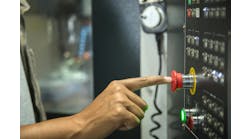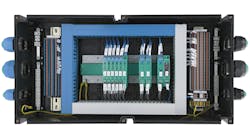What do you get when you combine a barefoot 12-year-old kid, a basement and a plugged-in TV with the cover removed? Is the answer me, a near-death experience or an electrical engineer? The answer is all the above. I clearly remember the effects of electrical current through the human body. The painful shock with loss of muscular control is still a vivid memory 40 years later. I couldn't let go, but fortunately my arm muscles extended throwing the TV across the basement and bouncing me off the sofa.
As an engineer, technician or electrician, you may need to test the control circuit with the power on. However, the only thing that should be touching the live circuit is the probes of a suitable multimeter. Once the problem is found, suitable insulated tools should be used to correct the problem, but only after the power is turned off.
You may have met the electrician who brags about leaving the power on or getting shocked all the time. I've met several, and, even though they make fun of my tender, callus-free hand when they shake it, I'm not impressed when they work on an electrical circuit with the power on. Quite the opposite. I've seen the effects of electrical shock and felt it once, as a professional, on the job.
I was terminating wires to 120-Vac output terminals in a large five-door electrical enclosure. Before I started, I asked the electrician if the power was off, and he looked at the disconnect, which I couldn't see, and said, “Yes.” The third termination shocked me. I took out a 1-1/4-A fuse through my hand and arm. The current exited my elbow where it was pinned against the grounded enclosure door post. I fell backward once the fuse blew, and so did the electrician. My elbow hurt for months. Bottom line, shut off the power and check it yourself before continuing. That's part of a proper lockout/tagout procedure.
Occupational Safety and Health Administration (OSHA) Standard 29 CFR, Part 1910, has much to say about electrical safety, especially Subpart I—Personal Protective Equipment; 1910 Subpart S—Electrical; and 1910.147—The control of hazardous energy (lockout/tagout). The OSHA standards are online here: www.controldesign.com/osha1910. It will take a lot of time to read them, but you should.
The danger of shocks, arcs and fires are present when working in most industrial control panels, and it becomes a real safety concern above 50 V. While a standard 120 Vac source can easily provide a deadly shock, the common 208/240- and 480-Vac sources will have you seeing red right before extreme pain, severe muscular contractions and respiratory arrest signal the possibility of your death. Add a little more current and the nerve damage and ventricular fibrillation, causing a nonfunctioning heart, makes death likely. And I have not even gotten to the burn part yet.
The burn danger is always present in the form of any electrical current passing through your body over about 150 mA. And then there is the dreaded arc flash. Of course, an electrical shock can kill you, but the result of an arc flash can be even more horrific.
The arc flash is self-extinguishing below 600 V when the alternating current goes to zero, but it will still probably burn you, as arc flash events can reach temperatures over 30,000 °F. Worse, in medium-voltage applications that start around 600 V, the plasma arc doesn't stop until the related circuit and components melt enough to open the circuit.
At medium voltages, when an arc occurs, it is like an explosion due to the large amount of power feeding the arc along with the gas and plasma created, but even sparks from 120-Vac circuits can burn you. Did you read the personal protection (PPE) standards in OSHA 1910 yet? If not, consider the radiation involved in an arc-flash event. The concentrated power of the event can release so much ultraviolet light that a full body sunburn can happen in milliseconds.
According to the National Institute for Occupational Safety and Health (NIOSH), 3,378 worker deaths were due to on-the-job electrical injuries from 1992 through 2002 (www.controldesign.com/nioshdeaths). While that is only about 5% of all occupational deaths, that's almost one death per day, making it the fourth leading cause of work-related injury.
ALSO READ: The keys to robot selection, safety and collaboration
The most common work-related electrical deaths, 42%, were due to contact with overhead power lines. Failure to properly de-energize the electrical equipment was the second most common cause. Similarly, the third most common cause involved contact with electrical equipment that was thought to be de-energized but remained energized due to wiring mistakes or improperly identified wiring.
It's clear that machine builders, system integrators or any plant personnel working around electrical control cabinets are at a high risk of shock especially around new or retrofitted machines and equipment. These projects often have the controls guys and technicians working around live electrical control cabinets and machines with possible wiring errors, as well.
Keep in mind that NFPA 70E and NEC like to reference electrical shock, thermal heat, arc flash and blast when talking about electrical conductors and circuit parts. Those are correct descriptions, but I'm sure there are others, equally painful, that are missing. I know this since last time I cut through a live, 120-Vac, 20-A, improperly installed circuit conductor, the ball of molten metal, that burnt into my neck and took about two months to heal. It was just an explosive release of molten material, but not shocking.





